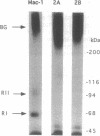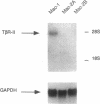Abstract
Ki-1 (CD30)+ cutaneous T-cell lymphomas CTCLs) are slowly progressive lymphomas in which initial spontaneous regression is often observed. To better understand the mechanisms of spontaneous regression and eventual tumor progression in Ki-1+ CTCLs, type beta transforming growth factor (TGF-beta)-mediated growth inhibition of clonally related cell lines derived from two time points, before and after tumor progression, was studied. TGF-beta 1 inhibited colony-forming efficiency (CFE) of a cell line (Mac-1) derived from clinically indolent Ki-1+ CTCLs but failed to inhibit CFE of Mac-2A and -2B cell lines from advanced CTCLs. To determine the basis for TGF-beta 1 resistance in advanced CTCL cells, we looked for possible defects in the expression of cell surface TGF-beta receptors. Mac-1 cells were found to express TGF-beta receptors I and II, which mediate growth inhibition, and the TGF-beta-binding proteoglycan betaglycan. In contrast, receptors I and II were not detected in CTCL lines Mac-2A and -2B even though these cell lines did express betaglycan. Various treatments that unmask or induce TGF-beta receptors in other cells failed to show evidence for these receptors in advanced CTCL cells. Loss of TGF-beta receptor expression in these cells correlated with a marked decrease in TGF-beta receptor II mRNA levels. Loss of cell surface TGF-beta receptors was also found in two of five other patients with T-cell lymphomas including the Sezary syndrome and a noncutaneous T-cell lymphoma, suggesting that loss of TGF-beta receptor expression may be a recurrent feature of human T-cell malignancies.
Full text
PDF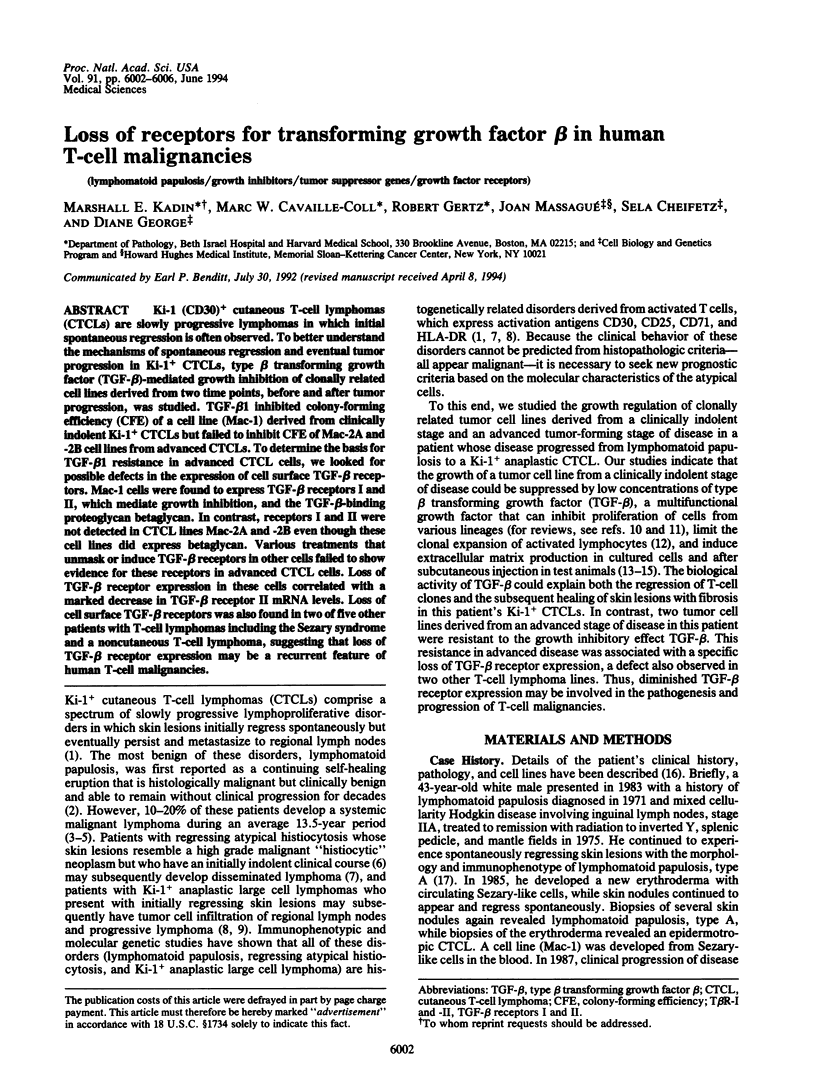
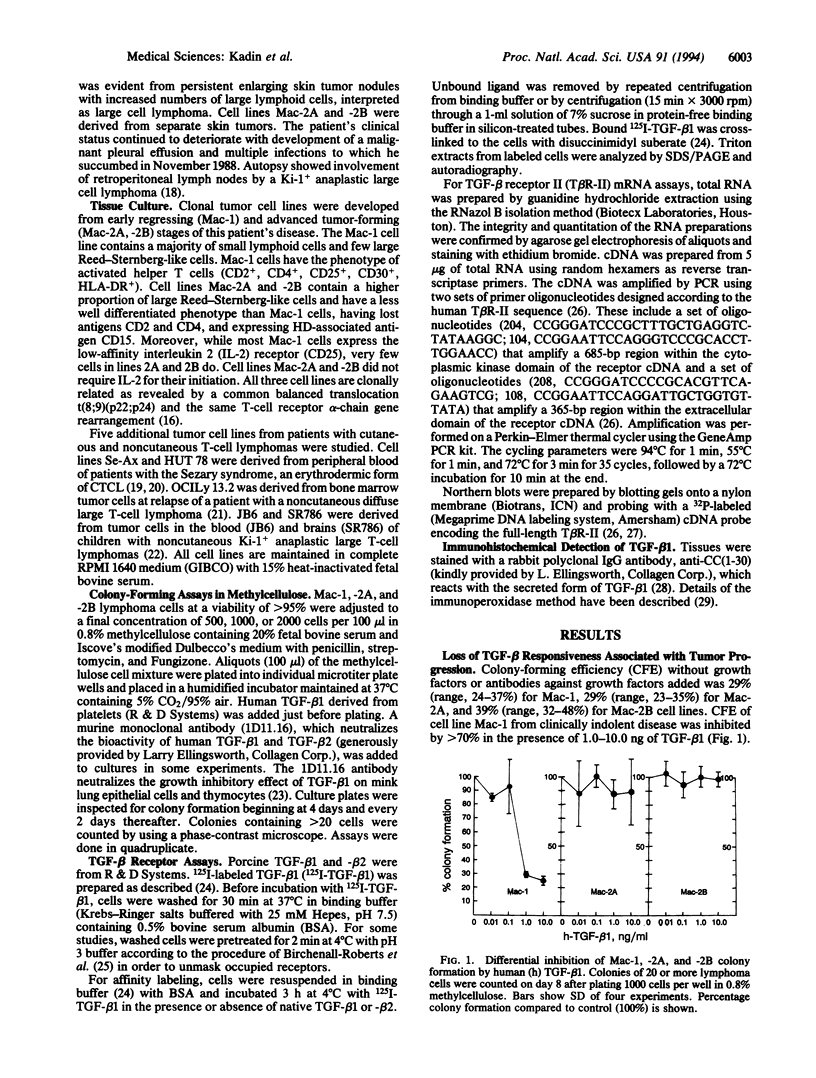
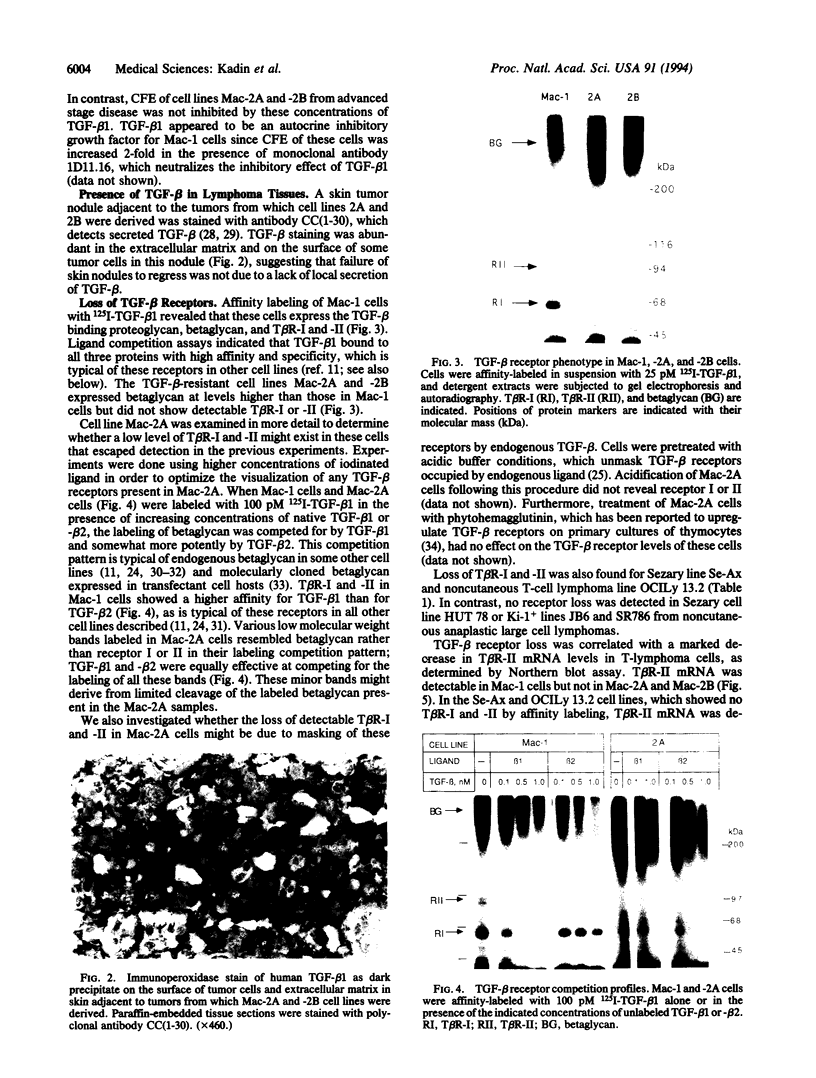
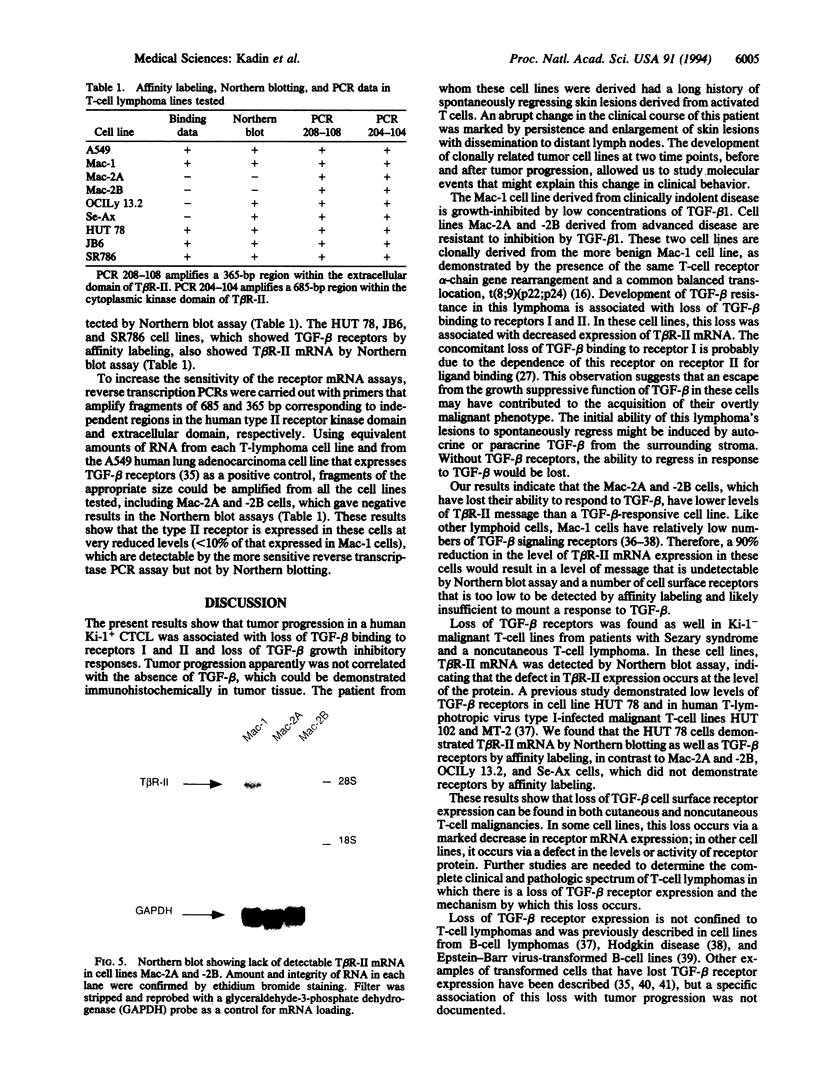
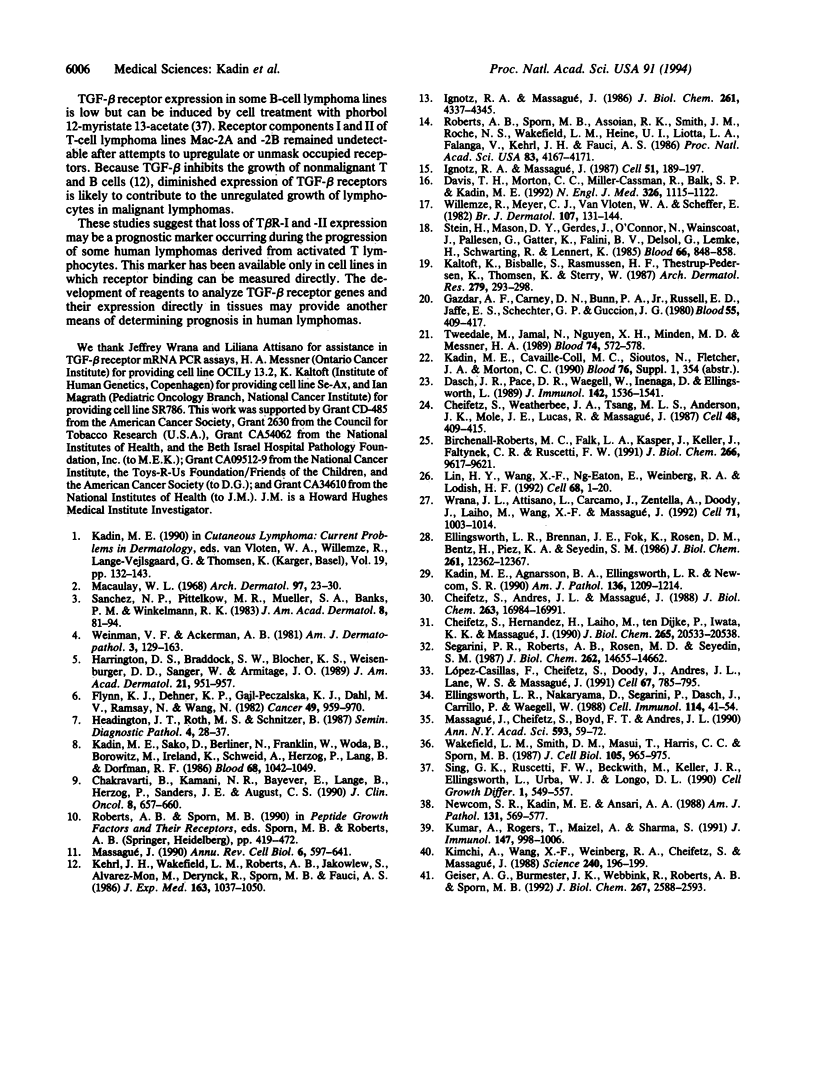
Images in this article
Selected References
These references are in PubMed. This may not be the complete list of references from this article.
- Birchenall-Roberts M. C., Falk L. A., Kasper J., Keller J., Faltynek C. R., Ruscetti F. W. Differential expression of transforming growth factor-beta 1 (TGF-beta 1) receptors in murine myeloid cell lines transformed with oncogenes. Correlation with differential growth inhibition by TGF-beta 1. J Biol Chem. 1991 May 25;266(15):9617–9621. [PubMed] [Google Scholar]
- Chakravarti V., Kamani N. R., Bayever E., Lange B., Herzog P., Sanders J. E., August C. S. Bone marrow transplantation for childhood Ki-1 lymphoma. J Clin Oncol. 1990 Apr;8(4):657–660. doi: 10.1200/JCO.1990.8.4.657. [DOI] [PubMed] [Google Scholar]
- Cheifetz S., Andres J. L., Massagué J. The transforming growth factor-beta receptor type III is a membrane proteoglycan. Domain structure of the receptor. J Biol Chem. 1988 Nov 15;263(32):16984–16991. [PubMed] [Google Scholar]
- Cheifetz S., Hernandez H., Laiho M., ten Dijke P., Iwata K. K., Massagué J. Distinct transforming growth factor-beta (TGF-beta) receptor subsets as determinants of cellular responsiveness to three TGF-beta isoforms. J Biol Chem. 1990 Nov 25;265(33):20533–20538. [PubMed] [Google Scholar]
- Cheifetz S., Weatherbee J. A., Tsang M. L., Anderson J. K., Mole J. E., Lucas R., Massagué J. The transforming growth factor-beta system, a complex pattern of cross-reactive ligands and receptors. Cell. 1987 Feb 13;48(3):409–415. doi: 10.1016/0092-8674(87)90192-9. [DOI] [PubMed] [Google Scholar]
- Dasch J. R., Pace D. R., Waegell W., Inenaga D., Ellingsworth L. Monoclonal antibodies recognizing transforming growth factor-beta. Bioactivity neutralization and transforming growth factor beta 2 affinity purification. J Immunol. 1989 Mar 1;142(5):1536–1541. [PubMed] [Google Scholar]
- Davis T. H., Morton C. C., Miller-Cassman R., Balk S. P., Kadin M. E. Hodgkin's disease, lymphomatoid papulosis, and cutaneous T-cell lymphoma derived from a common T-cell clone. N Engl J Med. 1992 Apr 23;326(17):1115–1122. doi: 10.1056/NEJM199204233261704. [DOI] [PubMed] [Google Scholar]
- Ellingsworth L. R., Brennan J. E., Fok K., Rosen D. M., Bentz H., Piez K. A., Seyedin S. M. Antibodies to the N-terminal portion of cartilage-inducing factor A and transforming growth factor beta. Immunohistochemical localization and association with differentiating cells. J Biol Chem. 1986 Sep 15;261(26):12362–12367. [PubMed] [Google Scholar]
- Ellingsworth L. R., Nakayama D., Segarini P., Dasch J., Carrillo P., Waegell W. Transforming growth factor-beta s are equipotent growth inhibitors of interleukin-1-induced thymocyte proliferation. Cell Immunol. 1988 Jun;114(1):41–54. doi: 10.1016/0008-8749(88)90253-5. [DOI] [PubMed] [Google Scholar]
- Flynn K. J., Dehner L. P., Gajl-Peczalska K. J., Dahl M. V., Ramsay N., Wang N. Regressing atypical histiocytosis: a cutaneous proliferation of atypical neoplastic histiocytes with unexpectedly indolent biologic behavior. Cancer. 1982 Mar 1;49(5):959–970. doi: 10.1002/1097-0142(19820301)49:5<959::aid-cncr2820490521>3.0.co;2-j. [DOI] [PubMed] [Google Scholar]
- Gazdar A. F., Carney D. N., Bunn P. A., Russell E. K., Jaffe E. S., Schechter G. P., Guccion J. G. Mitogen requirements for the in vitro propagation of cutaneous T-cell lymphomas. Blood. 1980 Mar;55(3):409–417. [PubMed] [Google Scholar]
- Geiser A. G., Burmester J. K., Webbink R., Roberts A. B., Sporn M. B. Inhibition of growth by transforming growth factor-beta following fusion of two nonresponsive human carcinoma cell lines. Implication of the type II receptor in growth inhibitory responses. J Biol Chem. 1992 Feb 5;267(4):2588–2593. [PubMed] [Google Scholar]
- Harrington D. S., Braddock S. W., Blocher K. S., Weisenburger D. D., Sanger W., Armitage J. O. Lymphomatoid papulosis and progression to T cell lymphoma: an immunophenotypic and genotypic analysis. J Am Acad Dermatol. 1989 Nov;21(5 Pt 1):951–957. doi: 10.1016/s0190-9622(89)70281-4. [DOI] [PubMed] [Google Scholar]
- Headington J. T., Roth M. S., Schnitzer B. Regressing atypical histiocytosis: a review and critical appraisal. Semin Diagn Pathol. 1987 Feb;4(1):28–37. [PubMed] [Google Scholar]
- Ignotz R. A., Massagué J. Cell adhesion protein receptors as targets for transforming growth factor-beta action. Cell. 1987 Oct 23;51(2):189–197. doi: 10.1016/0092-8674(87)90146-2. [DOI] [PubMed] [Google Scholar]
- Ignotz R. A., Massagué J. Transforming growth factor-beta stimulates the expression of fibronectin and collagen and their incorporation into the extracellular matrix. J Biol Chem. 1986 Mar 25;261(9):4337–4345. [PubMed] [Google Scholar]
- Kadin M. E., Agnarsson B. A., Ellingsworth L. R., Newcom S. R. Immunohistochemical evidence of a role for transforming growth factor beta in the pathogenesis of nodular sclerosing Hodgkin's disease. Am J Pathol. 1990 Jun;136(6):1209–1214. [PMC free article] [PubMed] [Google Scholar]
- Kadin M. E., Sako D., Berliner N., Franklin W., Woda B., Borowitz M., Ireland K., Schweid A., Herzog P., Lange B. Childhood Ki-1 lymphoma presenting with skin lesions and peripheral lymphadenopathy. Blood. 1986 Nov;68(5):1042–1049. [PubMed] [Google Scholar]
- Kaltoft K., Bisballe S., Rasmussen H. F., Thestrup-Pedersen K., Thomsen K., Sterry W. A continuous T-cell line from a patient with Sézary syndrome. Arch Dermatol Res. 1987;279(5):293–298. doi: 10.1007/BF00431220. [DOI] [PubMed] [Google Scholar]
- Kehrl J. H., Wakefield L. M., Roberts A. B., Jakowlew S., Alvarez-Mon M., Derynck R., Sporn M. B., Fauci A. S. Production of transforming growth factor beta by human T lymphocytes and its potential role in the regulation of T cell growth. J Exp Med. 1986 May 1;163(5):1037–1050. doi: 10.1084/jem.163.5.1037. [DOI] [PMC free article] [PubMed] [Google Scholar]
- Kimchi A., Wang X. F., Weinberg R. A., Cheifetz S., Massagué J. Absence of TGF-beta receptors and growth inhibitory responses in retinoblastoma cells. Science. 1988 Apr 8;240(4849):196–199. doi: 10.1126/science.2895499. [DOI] [PubMed] [Google Scholar]
- Kumar A., Rogers T., Maizel A., Sharma S. Loss of transforming growth factor beta 1 receptors and its effects on the growth of EBV-transformed human B cells. J Immunol. 1991 Aug 1;147(3):998–1006. [PubMed] [Google Scholar]
- López-Casillas F., Cheifetz S., Doody J., Andres J. L., Lane W. S., Massagué J. Structure and expression of the membrane proteoglycan betaglycan, a component of the TGF-beta receptor system. Cell. 1991 Nov 15;67(4):785–795. doi: 10.1016/0092-8674(91)90073-8. [DOI] [PubMed] [Google Scholar]
- Macaulay W. L. Lymphomatoid papulosis. A continuing self-healing eruption, clinically benign--histologically malignant. Arch Dermatol. 1968 Jan;97(1):23–30. doi: 10.1001/archderm.97.1.23. [DOI] [PubMed] [Google Scholar]
- Massagué J., Cheifetz S., Boyd F. T., Andres J. L. TGF-beta receptors and TGF-beta binding proteoglycans: recent progress in identifying their functional properties. Ann N Y Acad Sci. 1990;593:59–72. doi: 10.1111/j.1749-6632.1990.tb16100.x. [DOI] [PubMed] [Google Scholar]
- Massagué J. The transforming growth factor-beta family. Annu Rev Cell Biol. 1990;6:597–641. doi: 10.1146/annurev.cb.06.110190.003121. [DOI] [PubMed] [Google Scholar]
- Newcom S. R., Kadin M. E., Ansari A. A. Production of transforming growth factor-beta activity by Ki-1 positive lymphoma cells and analysis of its role in the regulation of Ki-1 positive lymphoma growth. Am J Pathol. 1988 Jun;131(3):569–577. [PMC free article] [PubMed] [Google Scholar]
- Nossal G. J. The molecular and cellular basis of affinity maturation in the antibody response. Cell. 1992 Jan 10;68(1):1–2. doi: 10.1016/0092-8674(92)90198-l. [DOI] [PubMed] [Google Scholar]
- Roberts A. B., Sporn M. B., Assoian R. K., Smith J. M., Roche N. S., Wakefield L. M., Heine U. I., Liotta L. A., Falanga V., Kehrl J. H. Transforming growth factor type beta: rapid induction of fibrosis and angiogenesis in vivo and stimulation of collagen formation in vitro. Proc Natl Acad Sci U S A. 1986 Jun;83(12):4167–4171. doi: 10.1073/pnas.83.12.4167. [DOI] [PMC free article] [PubMed] [Google Scholar]
- Sanchez N. P., Pittelkow M. R., Muller S. A., Banks P. M., Winkelmann R. K. The clinicopathologic spectrum of lymphomatoid papulosis: study of 31 cases. J Am Acad Dermatol. 1983 Jan;8(1):81–94. doi: 10.1016/s0190-9622(83)70011-3. [DOI] [PubMed] [Google Scholar]
- Segarini P. R., Roberts A. B., Rosen D. M., Seyedin S. M. Membrane binding characteristics of two forms of transforming growth factor-beta. J Biol Chem. 1987 Oct 25;262(30):14655–14662. [PubMed] [Google Scholar]
- Sing G. K., Ruscetti F. W., Beckwith M., Keller J. R., Ellingsworth L., Urba W. J., Longo D. L. Growth inhibition of a human lymphoma cell line: induction of a transforming growth factor-beta-mediated autocrine negative loop by phorbol myristate acetate. Cell Growth Differ. 1990 Nov;1(11):549–557. [PubMed] [Google Scholar]
- Stein H., Mason D. Y., Gerdes J., O'Connor N., Wainscoat J., Pallesen G., Gatter K., Falini B., Delsol G., Lemke H. The expression of the Hodgkin's disease associated antigen Ki-1 in reactive and neoplastic lymphoid tissue: evidence that Reed-Sternberg cells and histiocytic malignancies are derived from activated lymphoid cells. Blood. 1985 Oct;66(4):848–858. [PubMed] [Google Scholar]
- Tweeddale M., Jamal N., Nguyen A., Wang X. H., Minden M. D., Messner H. A. Production of growth factors by malignant lymphoma cell lines. Blood. 1989 Aug 1;74(2):572–578. [PubMed] [Google Scholar]
- Wakefield L. M., Smith D. M., Masui T., Harris C. C., Sporn M. B. Distribution and modulation of the cellular receptor for transforming growth factor-beta. J Cell Biol. 1987 Aug;105(2):965–975. doi: 10.1083/jcb.105.2.965. [DOI] [PMC free article] [PubMed] [Google Scholar]
- Weinman V. F., Ackerman A. B. Lymphomatoid papulosis. A critical review and new findings. Am J Dermatopathol. 1981 Summer;3(2):129–163. doi: 10.1097/00000372-198100320-00004. [DOI] [PubMed] [Google Scholar]
- Willemze R., Meyer C. J., Van Vloten W. A., Scheffer E. The clinical and histological spectrum of lymphomatoid papulosis. Br J Dermatol. 1982 Aug;107(2):131–144. doi: 10.1111/j.1365-2133.1982.tb00331.x. [DOI] [PubMed] [Google Scholar]
- Wrana J. L., Attisano L., Cárcamo J., Zentella A., Doody J., Laiho M., Wang X. F., Massagué J. TGF beta signals through a heteromeric protein kinase receptor complex. Cell. 1992 Dec 11;71(6):1003–1014. doi: 10.1016/0092-8674(92)90395-s. [DOI] [PubMed] [Google Scholar]



